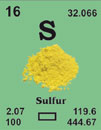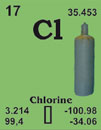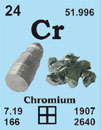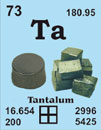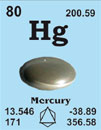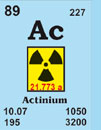Material, Technologie
& Kristalle GmbH
& Kristalle GmbH
Ihre Verbindung zu uns

-
 English
English
-
 Deutsch
Deutsch
Warenkorb
0
Artikel
Artikel
Keine Artikel
0,00 €
Gesamt
Gesamt zzgl. MwSt.
Artikel wurde in den Korb gelegt
Menge
Sie haben 0 Artikel in Ihrem Warenkorb.
Es gibt 1 Artikel in Ihrem Warenkorb.
Versandkosten (o. MwSt.)
noch festzulegen
Gesamt
(o. MwSt.)
Cadmium (Cd)
Wir sind führender Hersteller und Lieferant von Forschungsmaterialien
Cadmium 48Cd112.40
1817 von F. Stromeyer in Göttingen, Deutschland, entdeckt.
[Latin: cadmia = Kalamin]
French: cadmium
English: Cadmium
Italian: cadmio
Spanish: cadmio
Beschreibung: Silberweißes Metall. Läuft in Luft an, ist in Säuren, aber nicht in Laugen löslich. Wird für Akkumulatoren, Legierungen und Pigmente verwendet.
Cadmium single crystal properties
| State: | Single crystal |
|---|---|
| Crystal structure: | rhombohedral |
| Production method: | Bridgman |
| Standard size: | diameter 12 thickness 1-2mm |
| Orientation: | (0001) |
| Orientation accuracy: | <2°, <1°, <0.4° or <0.1° |
| Polishing: | as cut, one or two sides polished |
| Roughness of surface: | <0.03 µm |
| Purity: | 99.999% |
Further Materials properties
| Crystal structure: | (cell dimensions/pm), space group, h.c.p. (a=297.94, c=561.86), P63/mmc |
|---|---|
| X-ray diffractions mass absorption coefficients: | CuKa 231 (µ/r) / cm2g-1 MoKa 27.5 (µ/r) / cm2g-1 |
| Neutron scattering length: | 0.51 b/10-12 cm |
| Thermal neutron capture cross-section: | 2450 sa / barns |
| Density: | 8.65 kg/m-3 |
| Melting point: | 320.95 °C / 594.1 °K |
| Boiling point: | 764.85 °C / 1038 °K |
| Molar volume: | 13.00 cm3 |
| Thermal conductivity: | 96.8 [300 K] Wm-1K-1 |
| Coefficient of linear thermal expansion: | 29.8 x 10-6 K-1 |
| Electrical resistivity: | 6.83x10-8 [293 K] Wm |
| Mass magnetic susceptibility: | -2.21 x 10-9(s) kg-1m3 |
| Young's modulus: | 62.6 GPa |
| Rigidity modulus: | 24.0 GPa |
| Bulk modulus: | 51.0 GPa |
| Poisson's ratio: | 0.30 GPa |
| Radi: | Cd2+ 103; Cd+ 114; atomic 149; covalent 141 |
| Electronegativity: | 1.69 (Pauling); 1.46 (Allred); 4.33 eV (absolute) |
| Effective nuclear charge: | 4.35 (Slater); 8.19 (Clementi); 11.58 (Froese-Fischer) |
| Number of Isotopes (incl. nuclear isomers): | 31 |
| Isotope mass range: | 99 -> 124 |
Biological data
| Biological role: | None has been proved, although suspected. It is stimulatory |
|---|---|
| Toxicity | |
| Toxic intake: | 17 mg kg-1 (chloride, oral, rat) |
| Lethal intake: | LD50 (chloride, oral, guinea pig) = 63 mg kg-1 |
| Hazards: | Cadmium is toxic but its emetic action means that little is absorbed, so fatal poisoning rarely occurs. Cadmium is carcinogenic and teratogenic. |
| Level in humans | |
| Blood: | 0.0052 mg dm-3 |
| Bone: | <1.8 ppm |
| Liver: | 2 - 22 ppm |
| Muscle: | 0.14 - 3.2 ppm |
| Daily dietary intake: | 0.007 - 3 mg |
| Total mass of element in average [70 kg] person: |
50 mg |
Geological data
| Minerals: | Many minerals are known, and aluminium is present in many other minerals | |||
|---|---|---|---|---|
| Mineral | Formula | Density | Hardness | Crystal apperance |
| Cadmoselite | a-CdSe | 5.6 | n.a. | hex., res./adam. black |
| Greenockite | CdS | 4.9 | 3 - 3.5 | hex., yellow, tiny prisms |
| Otavite | CdCO3 | 5.03 | n.a. | rhom., adam. white/brown |
| Chief ore: | none as such, most cadmium is produced as a by-product of the smelting of zinc from its ore ZnS, in which CdS is a significant impurity. |
|---|---|
| World production: | 13900 tonnes/year |
| Main mining areas: | see zinc |
| Reserves: | see zinc |
| Specimen: | available as foil, granules, powder, rod, shot, stick ore wire. CARE ! |
| Abundances | |
|---|---|
| Sun: | 71 (relative to H = 1 x 1023) |
| Earth's crust: | 0.11 ppm |
| Seawater: | |
| Atlantic surface: | 1.1 x 10-6 ppm |
| Atlantic deep: | 38 x 10-6 ppm |
| Pacific surface: | 1.1 x 10-6 ppm |
| Pacific deep: | 100 x 10-6 ppm |
| Residence time: | 30 years |
| Classification: | recycled |
| Oxidation state: | II |
Other sizes and specifications on request
Übersicht der Elemente mit Zugang zu unserem Shop
Tel.: +49 (0) 2461 - 9352 - 0
Fax: +49 (0) 2461 - 9352 - 11
Fax: +49 (0) 2461 - 9352 - 11
















